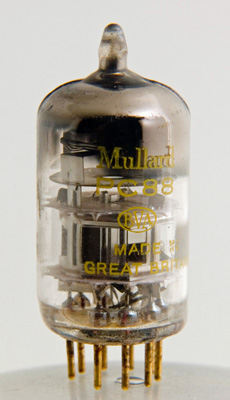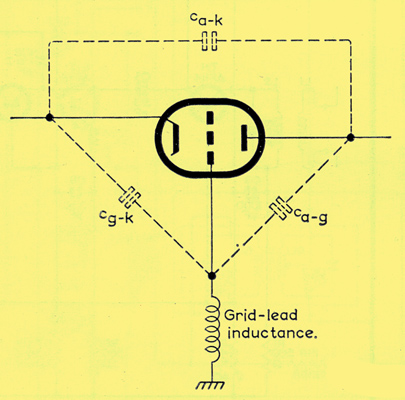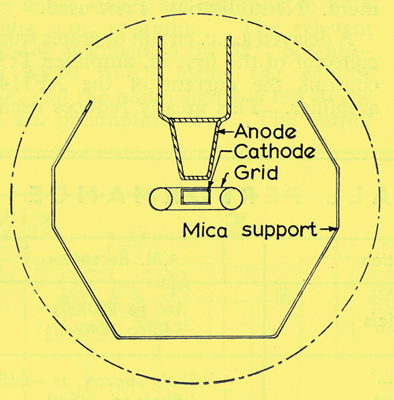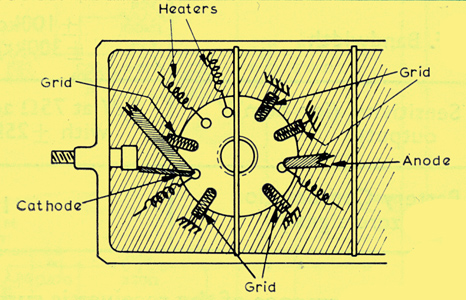|

The Mullard PC88.
The proposed extension of television broadcasting and the change from the 405-line to the 625-line standard can only be made by utilising the ultra high frequency wavebands. BBC test transmissions in these wavebands are due to start almost immediately, and public transmissions cannot be very long delayed. Consequently, television receivers which are not soon to be outdated must be designed with facilities for receiving UHF and VHF transmissions. In anticipation of this requirement, Mullard have recently introduced a new valve - the PC88 - which is intended specifically for operation as a UHF RF amplifier.
UHF Operation
The main performance requirements of a valve operating at UHF. as a grounded-grid RF amplifier are adequate power gain with a good margin of stability, and a low noise factor. To achieve these, a valve must have a high value of mutual conductance, low values of inter-electrode capacitance, low values of electron transit times and a low value of grid-lead inductance.

Fig. 1 - Feedback paths with grounded-grid triode.
The possible feedback paths in a grounded-grid triode amplifier are shown in Fig. 1. They consist of the inter-electrode capacitances and the grid-lead inductance. Undesirable resonance can occur between these components and it is necessary to ensure that the resonant frequency is very high in order that self-neutralising does not occur during UHF operation. A high value of resonant frequency is obtained when the grid-lead inductance is small, Ca-g and Cg-k are small and Ca-k is large.
A high value of Ca-k cannot be tolerated, however, because it is a direct source of feedback, and good UHF. performance is thus the result of a compromise between a high self-neutralising frequency and a low value of anode-to-cathode capacitance.
A high value of mutual conductance and low value of transit time both require small inter-electrode spacings if the valve is to be compact and the operating voltages reasonably low. Such spacings, however, will result in high values of inter-electrode capacitance unless the facing areas of the electrodes are reduced as much as possible. In the PC88, small effective electrode areas are achieved by means of a single-sided electrode structure. A horizontal cross-section of this structure is illustrated in Fig. 2
Anode

Fig. 2 - Diagram illustrating horizontal cross section of PC88 electrode structure.
The design of the anode is governed by the requirements that its surface area must be large enough to ensure adequate heat dissipation, and the active area facing the grid and cathode must be small to minimise the inter-electrode capacitances. The shape of the anode of the PC88 is one commonly used in frame-grid valves, but because of the particular need for small capacitances, the 'nose' of the anode has been made as long as possible so that the fixing tags and the grid backbones are well separated.
Grid
Close control of the mechanical tolerances on the grid-to-cathode spacing of the PC88 is achieved by the use of a frame grid. This control is vital with a single-sided electrode structure, since the compensation afforded by a conventional double-sided structure is absent. The tolerances of the special mica supports used are improved by a factor of two or three times compared with the normal type of mica support. The grid backbones of the PC88 are thicker than usual, so that when the cathode is placed eccentrically with its emissive surface close to the grid, the other surface is well away from the grid and thus contributes little to the grid-to-cathode capacitance.
It is important for UHF operation that the grid lead inductance of a valve should be small since the grid must be effectively earthed. To achieve this in the PC88, the grid is connected to five base pins, and thick silver-plated leads are used between the grid backbones and the base pins. In addition, the height of the internal cone of the glass base is smaller than usual, thus enabling the electrode assembly to be mounted close to the pins. The thick grid leads also serve to screen the heater, cathode and anode connecting leads from each other, and thus help to minimise inter-electrode capacitances in the valve. The pinning of the PC88 is shown in Fig. 3.

Fig. 3 - PC88 pinning.
Cathode
Only one side of the cathode of the PC88 is used, and this is placed close to the grid, facing the anode. The emissive area must be large enough to permit a realistic cathode-current rating, but must also be a compromise between the conflicting requirements of high mutual conductance and low grid-to-cathode capacitance.
Because of the closeness of the grid and cathode, small variations in the spacing resulting, for example, from any unevenness of the emissive surface can give rise to large spreads in the electrical characteristics of the valve. To minimise surface irregularities, a specially prepared cathode having a thin emissive coating and an extremely flat surface is used in the PC88.
|